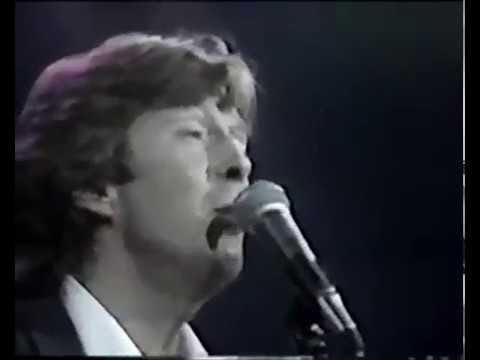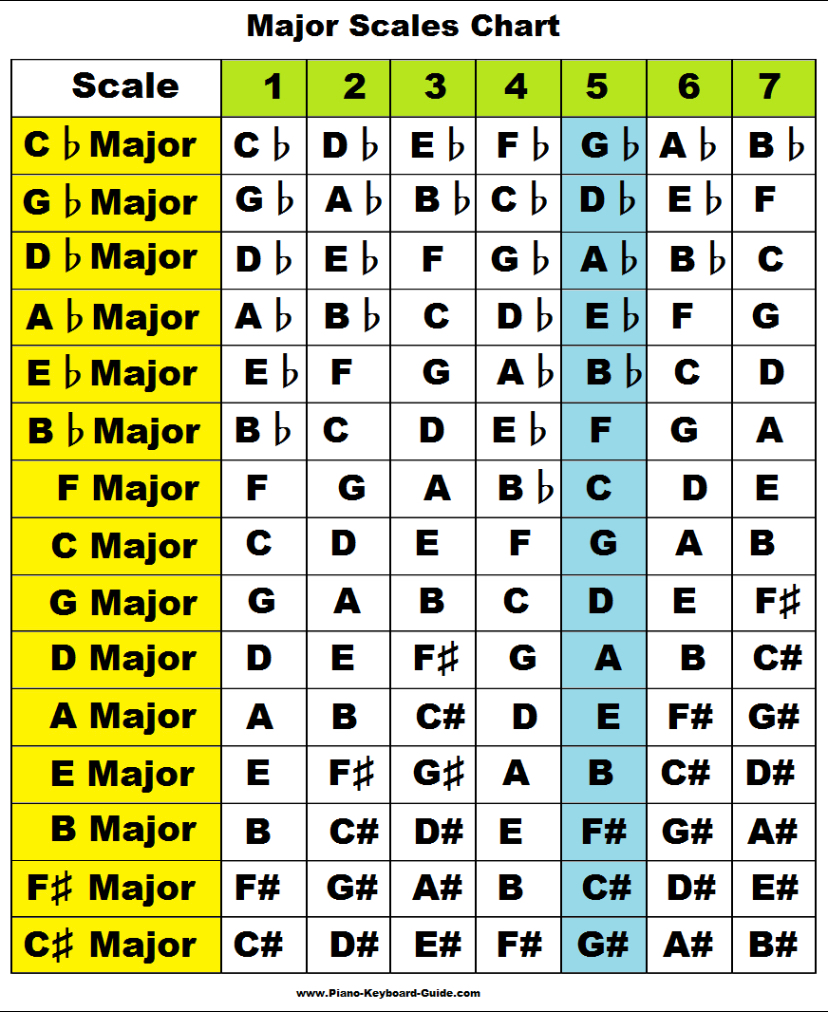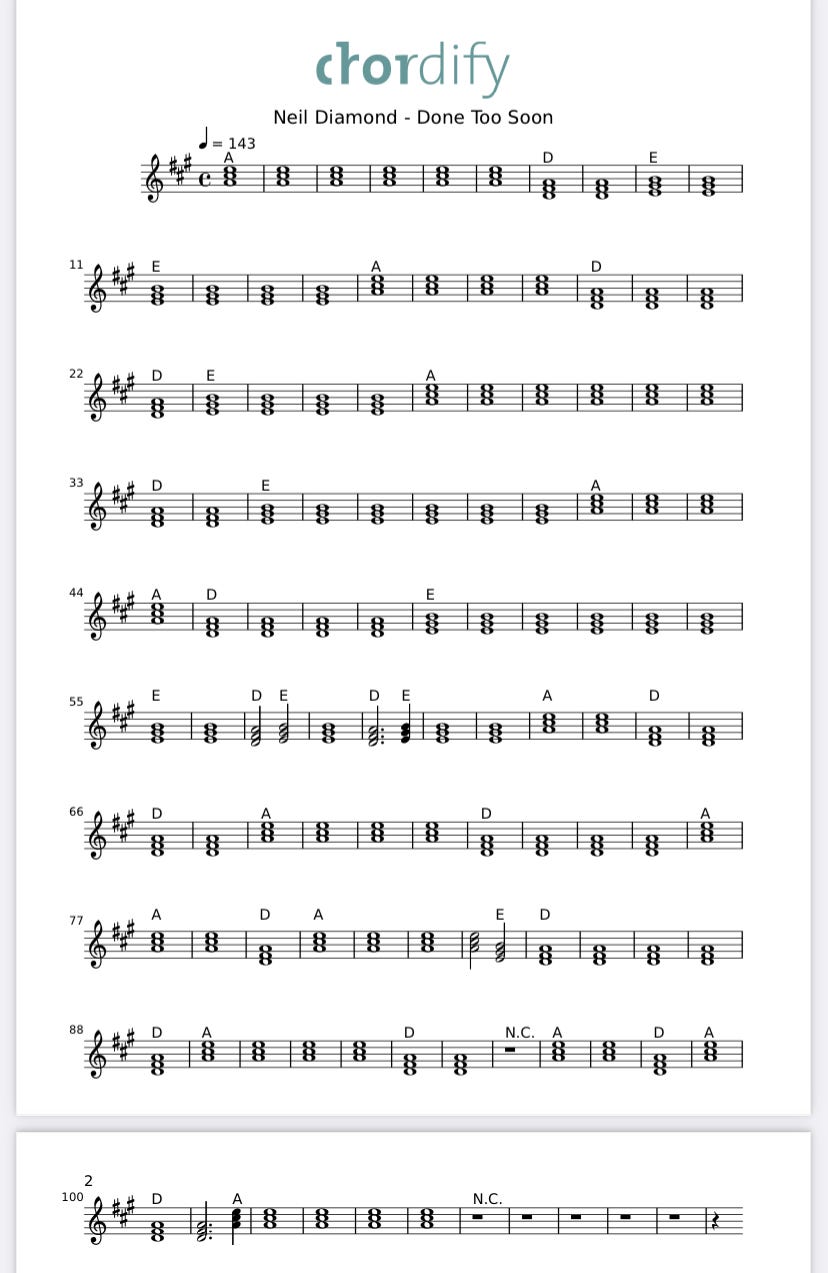Rest In Peace, Mr. Randy Meisner, bassist/vocalist and a founding member of The Eagles
Last week’s rando lyrics: “Love My Way”, The Psychedelic Furs
Welcome to the Regular Friday Post! Last week we talked a bit about dynamics, and I wanted to follow up on that, then discuss some other aspects of music theory. (Ed. - “it’s not that bad! Promise!”) (Evil Ed. “Yes it is!!”)
Strictly speaking, “the dynamics of a piece are the variation in loudness between notes or phrases.” Credit: Wikipedia Link: Dynamics (music).
I’m not one to color strictly within the lines, so I would expand that definition to include “any changes” within a song that can draw the listeners attention on purpose to some note, phrase or even sectional structure of a song. For instance, I usually find some way to differentiate the bridge of a song I’ve written from the other sections/structures (verses, choruses). That can mean I play louder, or more softly, during the bridge, but that kinda makes audio engineers a little nutty, and gets lost a bit when a master recording is “normalized” for streaming services. Fair enough, so: what do?
If the song is mostly made up harmonically of the diatonic (meaning they belong in the key) triad chords of a song, there are several ways of differentiating the bridge (or any other structure) from other parts of the song. My favorite is to use some flavor of seven chords, especially a ii-7, V7, IMaj7 progression (called a 2, 5, 1). I know we talked a bit about that a few weeks ago, but it’s kinda important in the context of applying some sort of dynamics (purposeful changes, not necessarily just volume) between structures to draw the listener’s attention. As we talked about last week, we can use different spacing intervals (communicate with bandmates how you’re going to accomplish that!). Also, sectional tempo changes (see the Neil Diamond song below in the “A Song To Play” section), or even key changes within the song (example, “Layla”, Derek And The Dominoes [Eric Clapton and many others], which actually incorporates 3 key changes: Dminor, C#minor and CMajor (sorta) - (See this link: "Layla" ).
Another way to change things up is to introduce non-diatonic notes or chords within a song (Ed. A what? - that’s a more relevant question than you might think…).
It starts with a note.
“Diatonic” notes are the notes that “belong” in a scale according to the formula for a scale. “Non Diatonic” notes are ones that don’t actually belong (according to the formula) in a particular diatonic scale, but we often use them anyway. Sometimes.
In Western music, a Major scale is constructed according to one of the formulas in Western music that looks like this: WWHWWWH, where “W” stands for a whole step interval, and H stands for a half step interval. Two half steps equal a whole step.
(Ed. Note: There are a multitude of other types of scales in Western music, each with their own formula variations: minor [couple different flavors of that one], blues, pentatonic, chromatic, whole tone, and a bunch of different (more or less) “modes” that kinda give me a headache but if you really are morbidly curious, here’s a link. Have fun:
Scales - Ugh, Good God, Y'all! What Are They Good For, Huuuh!
Since practically everything in music just has to have two names (like me, I’ve got both kinds: Michael AND Acoustic…), a half-step is also known as a “semitone”. For reference, every key (both black and white) on a piano is one half-step/semitone apart from the keys (left or right, black or white) adjacent. Every fret on a guitar fretboard is one half-step/semitone apart from the fret above or below (“above” here means toward the headstock, “below” means toward the soundhole or pickups, though the direction changes to left or right laterally when you’re playing - just go with it for now…).
Why are there “half steps”? The answer is kinda, but kinda not, because of the way piano keys on a keyboard are “tuned” (pianos have wires tuned to the note that is to be produced when struck by the “hammer” portion of the “piano action mechanism” when an individual key is “played”….so….). It’s kind of a chicken-egg question - did the piano come first, or the scales, which include the semitones the piano plays, come first? Dunno. Where do guitar fretboards (or their predecessors, lutes and whatnot) fit in? Once again, I dunno.
As we’ve talked about before, the reference note (meaning all other notes are tuned in frequencies that refer to this note) of A4 (the “A” note in the 4th octave on a piano keyboard, left to right) was standardized more or less at 440Hz at some point (with some hubbub over that, some still insist on 432Hz…). A4 appears in a number of places on the guitar, most easily found on the 5th fret of the high E string, if you care…but even if you don’t, your “Snark” knows where it is, or at least what frequency it is, and every other tone’s frequency is relative to it.
I get we are soooo far down in the music theory weeds here we’re going to have to hack our way out with a machete in the coming weeks (Cool, we get machetes…). So for today I’m going to leave you with a sort of (very confusing) cheat sheet of all the Major diatonic scales available to use in Western music, because we only use 12 notes in total, and only 7 of those notes are used at a time in each scale according to the formula, and 8 notes in order can form an octave, and we use scales to create different flavors of chords according to a completely different (sorta, but just for fun, apparently…) formula and then after the chords are built from the notes, they magically transform from scales into keys (But not the piano kind! But also they sorta can be formed by the piano kind….).
It’ll be fun!!!
“But, Michael!!” you say (plaintively), “there are more than 12 scales on here!!”
Yes - because the seven “Natural” notes, represented by the white keys on the piano, only get one name each, C,D,E,F,G,A, or B. But the five “Accidentals” (represented by the black keys on a piano) get two names each, one sharp, one flat, but they’re same note: C#/Db, D#/Eb, F#/Gb, G#/Ab, A#/Bb.
Also, one of the “extra”scales is a sorta “trick” scale that may or may not actually exist anywhere but in some really weird and very old classical music, or, of course, in jazz, because in that world it’s, “Rules? Ain’t no damn rules here, punk!”
Also 2 of them are same scale, just using aliases to avoid detection.
Take those 3 out of the 8 scales with Accidentals as the root (which is also known as the “tonic”) and the 5 “real” accidentals rooted scales are left.
Here’s how we resolve the extra 3: So the very first row is Cb Major, which is odd because there isn’t a Cb (OMG!! It’s a GHOST scale!!). Well it kinda is. Because there is no accidental between B and C, Cb is nonexistent in the “accepted as normal music universe”. A Cb is actually just B, just as a B# is actually just C. The same situation exists between E and F. Why no E#/Fb, or B#/Cb? Because: “No accidentals in between E and F, or B and C; that’s why….suckers!” You can visually confirm this by looking at a keyboard - those are the two places where there is no black key between two white keys. So.
Why not? “Cuz!! ..THAT’s why not!” (Ed. I once did read the actual reason “why there aren’t accidentals in those two places” in an article, so there apparently is a reason, but it was kinda stupid and boring, so I forgot. Whatever. It’s just a thing to deal with in music and it does make the whole endeavor much more complex, but also much more interesting.)
So how do we deal with a scale that purports to be in Cb, but doesn’t actually exist? It exists if someone writes in that scale or key, but all they’re really doing is making life kinda miserable for a bunch of members of an orchestra or quartet. Cb is just B, and there were a few composers who actually wrote in Cb way back in the day, apparently just to say they could, while making life kinda miserable for unsuspecting horn, wind, and string section players who now had to transpose in their minds that they should play a B when the score showed a Cb note. Probably where the phrase “Dead Composer Walking” originally came from…
But don’t discount that it might show up in jazz, as well - because that’s where weird goes to gig on a Saturday night….just sayin’
In addition 2 of the “extra” scales in the chart: F# /Gb, and C# /Db - are the same exact scales, made up of notes at the same exact aural frequency, each just using the other’s ID to buy Fireball on a Friday night or avoid the draft or something. When playing in either scale, there can be only one….
Why did you start listing them from C instead of A, Michael? Because the C scale is unique, it’s the only scale that consists only of the Naturals, no sharps or flats, so by convention, we start there. And…
….because I said so! (Ed. He says, somewhat inexplicably flashing back to previously successful uses of such modern communication skills…kiddzzz)
It’s maddening!!
We’ll try to make a bit more sense of it next week….
Disclaimer: This Substack is free, always will be, and I receive no compensation or other benefit (except the unsolicited, occasional, and much appreciated shoutout from readers and other Substackers!) from any of the people or companies or products I link to or write about. Note some images and other material may be copyrighted by the original author or composer and appear here under the “Fair Use” doctrine. Link: Fair Use Note also I do not use any form of artificial intelligence in writing Michael Acoustic. It is possible that some external sources that I link to or quote, do use or contain AI generated material.
Michael Acoustic
Thanks new folks for taking us over 100 Subscribers!!!!!! Mika, the Cat, welcomes you!!
This Week’s Conversation With Mika:
Mika: I’m not wearing a funny Pope hat!
Me: It’s to celebrate 100 subscribers! And it cost me 2 bucks!
Mika: Then YOU wear it!
Me: sigh…
Links: (Ed. I ran out of space yesterday for links related to “Thursday stuff”, so today’s links are a mashup of both days)
From Mr. Griff Hamlin, Blues Guitar Unleashed:
From guitarplayer.com:
From Carvin Audio:
From the Disc Makers Blog:
Create A Wikipedia Page For Yourself
Explicit Songs On Streaming Platforms
From American Songwriter:
Paul McCartney's Favorite Guitars
From Acoustic Guitar Magazine:
A whole mess of YouTube videos:
This is cool:
This guy kinda makes me laugh as well as learn something:
I need to watch this a few more times, it’s that cool:
They’re the best IMHO!:
Other Voices:
If you aren’t signed with a fairly major label (and let’s face it, if you were you would probably be spending time by your pool or driving around in something other than a 19 year old pickup - like mine - instead of reading my Substack….), there’s a good chance you’ll be creating your own album art for the spot on your distributor’s webpage where it goes, or for social media purposes. Ms. Cabitt’s Substack is a really good place to look for ideas!
A Song To Play:
Done Too Soon
1971 single by Neil Diamond
“"Done Too Soon" is a song written, composed and performed by Neil Diamond, and released on his 1970 album Tap Root Manuscript. Listed as track 4 on side one of the album, it was jointly arranged by Marty Paich and Lee Holdridge and jointly produced by Diamond and Tom Catalano.” Credit: Wikipedia Link: Done Too Soon
(Ed: The syllable count for this song would have been a monster…just sayin’)
Chord Chart
4/4 time, Key of AMaj, fast (until the tempo change) 143 BPM - 3 easy chords
Lyrics (from Genius)
Jesus Christ, Fanny Brice
Wolfie Mozart and Humphrey Bogart
And Genghis Khan
And on to H. G. Wells
Ho Chi Minh, Gunga Din
Henry Luce and John Wilkes Booth
And Alexanders King and Graham Bell
Ramar Krishna, Mama Whistler
Patrice Lumumba and Russ Colombo
Karl and Chico Marx
Albert Camus
E. A. Poe, Henri Rousseau
Sholom Aleichem and Caryl Chessman
Alan Freed and Buster Keaton too
(Ed: this is the tempo change point. See the “ways to change up your music through dynamics” above)
And each one there
Has one thing shared
They have sweated beneath the same sun
Looked up in wonder at the same moon
And wept when it was all done
For bein' done too soon
For bein' done too soon
For bein' done
Ed. I always liked this song - it was a bit of a departure from Mr. Diamond’s usual style - in a good way…
Shameless self promotion section
My song is out! “Long Road Back” (click on link for streaming options)
What I’m Listening2: I was a bit lazy and went with one Spotify made for me based on listening, but their AI or elf or whatever did a reasonably good job picking this, so…Also, that’s not me in the picture, but I did go to his concert… That’s Brian Fallon, back on tour with Gaslight Anthem now after a solo break.
Cheers and keep playing!!
Michael Acoustic
“It’s never really final - you just run out of things you can bear to change…”









Congratulations on the century mark, Michael! I love Mika's celebratory mitre, as I'm sure she does, too, despite her disgruntled look! Didn't know of Meisner's passing. I wasn't familiar with that Diamond song (from the same era, I think, I enjoyed singing "Solitary Man" in karaoke!), but those lyrics remind me of that Dylan song with all the names (or words with the placards in the video), as well as Billy Joel's similarly wordy, "We Didn't Start the Fire." Great variety, Michael! As Mika might say...."Meow!"😺
Congrats on a hundy! (That’s how the kids talk...). “Cb is just B” - my new band name.
And Gsus is just alright with me.
And is it a coincidence that the “F” chord is the hardest to barre? ✌️